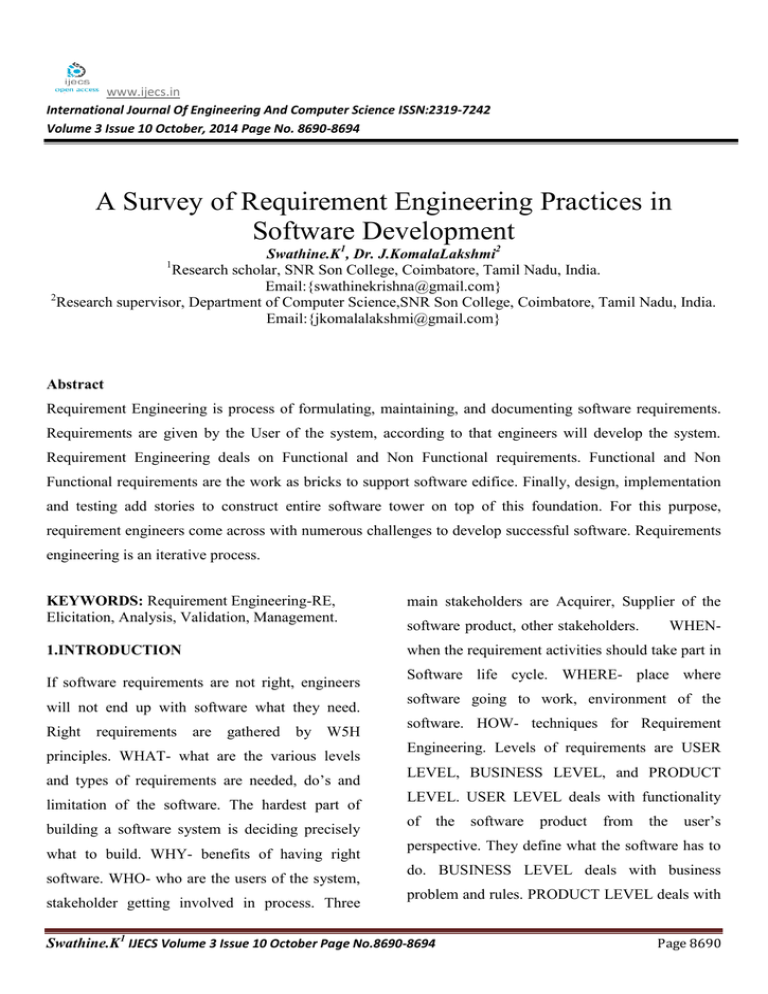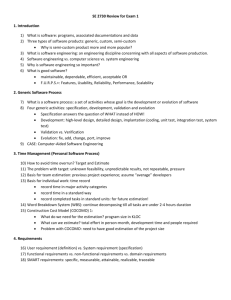www.ijecs.in International Journal Of Engineering And Computer Science ISSN:2319-7242
advertisement

www.ijecs.in
International Journal Of Engineering And Computer Science ISSN:2319-7242
Volume 3 Issue 10 October, 2014 Page No. 8690-8694
A Survey of Requirement Engineering Practices in
Software Development
Swathine.K1, Dr. J.KomalaLakshmi2
Research scholar, SNR Son College, Coimbatore, Tamil Nadu, India.
Email:{swathinekrishna@gmail.com}
2
Research supervisor, Department of Computer Science,SNR Son College, Coimbatore, Tamil Nadu, India.
Email:{jkomalalakshmi@gmail.com}
1
Abstract
Requirement Engineering is process of formulating, maintaining, and documenting software requirements.
Requirements are given by the User of the system, according to that engineers will develop the system.
Requirement Engineering deals on Functional and Non Functional requirements. Functional and Non
Functional requirements are the work as bricks to support software edifice. Finally, design, implementation
and testing add stories to construct entire software tower on top of this foundation. For this purpose,
requirement engineers come across with numerous challenges to develop successful software. Requirements
engineering is an iterative process.
KEYWORDS: Requirement Engineering-RE,
Elicitation, Analysis, Validation, Management.
main stakeholders are Acquirer, Supplier of the
1.INTRODUCTION
when the requirement activities should take part in
If software requirements are not right, engineers
will not end up with software what they need.
Right
requirements
are
gathered
by W5H
principles. WHAT- what are the various levels
and types of requirements are needed, do’s and
limitation of the software. The hardest part of
building a software system is deciding precisely
what to build. WHY- benefits of having right
software. WHO- who are the users of the system,
stakeholder getting involved in process. Three
software product, other stakeholders.
WHEN-
Software life cycle. WHERE- place where
software going to work, environment of the
software. HOW- techniques for Requirement
Engineering. Levels of requirements are USER
LEVEL, BUSINESS LEVEL, and PRODUCT
LEVEL. USER LEVEL deals with functionality
of
the
software
product
from
the
user’s
perspective. They define what the software has to
do. BUSINESS LEVEL deals with business
problem and rules. PRODUCT LEVEL deals with
Swathine.K1 IJECS Volume 3 Issue 10 October Page No.8690-8694
Page 8690
Interacting with stakeholders to discover
their requirements. Domain requirements
are also discovered at this stage.
constraints, requirements, specification of the
system.
Requirements
classification
and
organization.
Grouping related requirements and
organizing them into coherent cluster.
Requirements
prioritization
and
negotiation.
Prioritizing the requirements and resolving
their conflicts.
2. REVIEW OF LITERATURE
[1] Show outline of the field of Software system
Requirement Engineering. Describe main area of
Requirements Engineering practices. Shows what
is common and varies across in different types of
Software system.
[2] Gives challenges and crisis of Requirements
system requirements, and application encounter
Requirement documentation.
Requirements are documented and input to
next phase.
3.2 Requirements Analysis
all major challenges. Gives comparison between
Requirements analysis is the first stage in the
different techniques, represent a framework that
systems
illustrate the challenges.
development process. It encompasses task that go
Engineering. Requirement engineering process,
engineering
process
and
software
into determining the needs or conditions to meet
3. TECHNIQUE
for a new or altered product, taking account of the
3.1 Requirements Elicitation
Requirements
elicitation is
possibly conflicting requirements of the various
the
practice
of
collecting the requirements of a system from
users, customers and other stakeholders. The
practice
is
also
as requirements
requirements
sometimes
referred
gathering.
elicitation
called
to
Sometimes
requirements
discovery. Discovering requirements involves
technical staff working with customers to find out
about the application domain, the services that the
system
should
provide
and
the
system’s
operational constraints.
Stakeholders are end user, manager, engineers
involved in maintenance.
Requirement Elicitation involves
Requirement discovery.
stakeholders, such as beneficiaries or users.
Requirements analysis is critical to the success of
a development project. Requirements must be
actionable,
measurable,
testable,
related
to
identified business needs or opportunities, and
defined to a level of detail sufficient for system
design. Requirements can be functional and nonfunctional.
Requirement
Analysis
specifies
software characteristics, indicate software interact
with other system, establish the constraints that
software must meet. It categories and organises
them into related sub set, explore the relationship
between requirements. Examine requirements
consistency, omission and ambiguity. Prioritizing
the requirements based on customer need.
Swathine.K1 IJECS Volume 3 Issue 10 October Page No.8690-8694
Page 8691
Process Input
Requirements
analysis
System analysis
and control
Functional analysis
and allocation
Design synthesis
Process Output
3.3 Requirements Validation
requirements. The review team consists of
Requirement Validation is an activity in which
requirements engineers, customers, and users,
requirement specification is analysed in order to
marketing person and so on, this review team
ensure that the requirements are specified
basically
unambiguously. If any inconsistencies, omissions
inconstancies
and errors are identified then those are corrected
Validation work with a final draft of the
or
most
requirements document. Requirement document
validation
checks for completeness, consistency, technical
modified
commonly
during
used
validation.
requirement
The
mechanism is Formal Technical Review (FTR). In
identifies
or
conflicting
requirements,
unrealistic
requirements.
errors, ambiguous of requirements.
FTR, the review team validates the software
Requirement document
Organisational knowledge
List of problems
Requirement
Validation
Agreed action
Organisational standards
Validation Input
Requirements document
Swathine.K1 IJECS Volume 3 Issue 10 October Page No.8690-8694
Should be a complete version of the
document, not an unfinished draft.
Formatted and
organized according
to organizational standards
Page 8692
Organizational knowledge
Knowledge, often implicit, of the
organization which may be used to
judge the realism of the requirements
Organizational standards
Local standards e.g. for the
organization
of
the
requirements
requirements engineering process and system
development.
Why requirements get change?
Requirements are always incomplete and
inconsistent. New requirements occur
document
during the process as business needs
change and a better understanding of the
Validation Output
Problem list
List of discovered problems in the
requirements document
Agreed actions
List of agreed actions in response to
requirements problems. Some
problems may have several corrective
actions; some problems may have no
associated actions.
3.4 Requirement Management
system is developed.
System
customer
may
specify
the
requirements from business perspective
that
can
conflict
with
end
user
requirements.
During the development of the system its
business and technical environment may
get changed.
Requirement Management is the process of
managing changing requirements during the
Requirement Management Process
Requirement Identification
Requirements are individually
identified
Change management Process
Process plan followed when
analysing a requirement change
The amount of information about
requirement relationship is
maintained
Traceability Policies
Case Tool Support
The tool support which is
required to manage requirement
changes
Case tool support required for Requirement storage, Change management and Traceability management.
4. RESULT
requirements
validation
and
requirements
We discussed the state of the art of requirements
management, as a basic discipline in developing
engineering for Software Systems. We focused
Software Systems.
on requirements engineering activities namely
requirements elicitation, requirements analysis,
ACKNOWLEDGEMENT
Swathine.K1 IJECS Volume 3 Issue 10 October Page No.8690-8694
Page 8693
I
express
my
heartfelt
thanks
to
Dr.H.Balakrishnan, Principle, S.N.R son college
for making available in excellent infrastructure. I
thank my guide Dr.J.Komala Lakshmi, for her
support, effort to guide and encourage me. I thank
Dr.G.P.Ramesh Kumar, Head of the department
of Computer science for providing necessary
facilities. I thank Dr. AnnaSaro Vijendran, Head
of department of Computer Application.
REFERENCE
[1] Ranjeet Kaur Tajinder Singh “Analysis and
Need of Requirements Engineering”International
Journal of Computer Applications Volume 7–
No.14, October 2010 27 pp0975 – 8887.
[2]Sohail Asghar & Mahrukh Umar “Requirement
Engineering Challenges in Development of
Software Applications and Selection of Customeroff-the-Shelf (COTS) Components”, International
Journal of Software Engineering (IJSE), Volume
(1): Issue (2),pp:32-50.
[3] Seyed Hossein Siadat, Minseok Song
,“Understanding Requirement Engineering for
Context-Aware Service-Based
Applications”Journal of Software Engineering
and Applications, 2012, 5, pp:536-544
[4] M. Carrillo de Gea, Joaquín Nicolás
Juan,“Requirements Engineering Tools” IEEE
software,9 October 2010, pp:740-745.
[5] Aaron Sher, Vanteon Corporation,
“Requirements Engineering for Software
Engineers”, www.vanteon.com,7/12/2012.
Swathine.K1 IJECS Volume 3 Issue 10 October Page No.8690-8694
Page 8694


